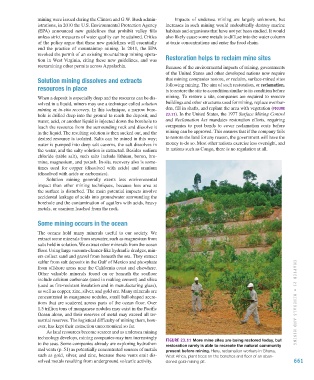Page 662 - Environment: The Science Behind the Stories
P. 662
mining were issued during the Clinton and G.W. Bush admin- Impacts of undersea mining are largely unknown, but
istrations, in 2010 the U.S. Environmental Protection Agency increases in such mining would undoubtedly destroy marine
(EPA) announced new guidelines that prohibit valley fills habitats and organisms that have not yet been studied. It would
unless strict measures of water quality can be attained. Critics also likely cause some metals to diffuse into the water column
of the policy argue that these new guidelines will essentially at toxic concentrations and enter the food chain.
end the practice of mountaintop mining. In 2011, the EPA
revoked the permit of an existing mountaintop mining opera-
tion in West Virginia, citing these new guidelines, and was Restoration helps to reclaim mine sites
reexamining other permits across Appalachia. Because of the environmental impacts of mining, governments
of the United States and other developed nations now require
Solution mining dissolves and extracts that mining companies restore, or reclaim, surface-mined sites
resources in place following mining. The aim of such restoration, or reclamation,
is to restore the site to a condition similar to its condition before
When a deposit is especially deep and the resource can be dis- mining. To restore a site, companies are required to remove
solved in a liquid, miners may use a technique called solution buildings and other structures used for mining, replace overbur-
mining or in-situ recovery. In this technique, a narrow bore- den, fill in shafts, and replant the area with vegetation (Figure
hole is drilled deep into the ground to reach the deposit, and 23.11). In the United States, the 1977 Surface Mining Control
water, acid, or another liquid is injected down the borehole to and Reclamation Act mandates restoration efforts, requiring
leach the resource from the surrounding rock and dissolve it companies to post bonds to cover reclamation costs before
in the liquid. The resulting solution is then sucked out, and the mining can be approved. This ensures that if the company fails
desired resource is isolated. Salts can be mined in this way; to restore the land for any reason, the government will have the
water is pumped into deep salt caverns, the salt dissolves in money to do so. Most other nations exercise less oversight, and
the water, and the salty solution is extracted. Besides sodium in nations such as Congo, there is no regulation at all.
chloride (table salt), such salts include lithium, boron, bro-
mine, magnesium, and potash. In-situ recovery also is some-
times used for copper (dissolved with acids) and uranium
(dissolved with acids or carbonates).
Solution mining generally exerts less environmental
impact than other mining techniques, because less area at
the surface is disturbed. The main potential impacts involve
accidental leakage of acids into groundwater surrounding the
borehole and the contamination of aquifers with acids, heavy
metals, or uranium leached from the rock.
Some mining occurs in the ocean
The oceans hold many minerals useful to our society. We
extract some minerals from seawater, such as magnesium from
salts held in solution. We extract other minerals from the ocean
floor. Using large vacuum-cleaner-like hydraulic dredges, min-
ers collect sand and gravel from beneath the sea. They extract
sulfur from salt deposits in the Gulf of Mexico and phosphate
from offshore areas near the California coast and elsewhere.
Other valuable minerals found on or beneath the seafloor
include calcium carbonate (used in making cement) and silica
(used as fire-resistant insulation and in manufacturing glass),
as well as copper, zinc, silver, and gold ore. Many minerals are
concentrated in manganese nodules, small ball-shaped accre-
tions that are scattered across parts of the ocean floor. Over CHAPTER 23 • Min ERA ls A nd Mining
1.5 trillion tons of manganese nodules may exist in the Pacific
Ocean alone, and their reserves of metal may exceed all ter-
restrial reserves. The logistical difficulty of mining them, how-
ever, has kept their extraction uneconomical so far.
As land resources become scarcer and as undersea mining
technology develops, mining companies may turn increasingly Figure 23.11 More mine sites are being restored today, but
to the seas. Some companies already are exploring hydrother- restoration rarely is able to recreate the natural community
mal vents (p. 51) as potentially concentrated sources of metals present before mining. Here, reclamation workers in Ghana,
such as gold, silver, and zinc, because these vents emit dis- West Africa, plant trees on the benches and floor of an aban-
solved metals resulting from underground volcanic activity. doned gold-mining pit. 661
M23_WITH7428_05_SE_C23.indd 661 13/12/14 11:29 AM

